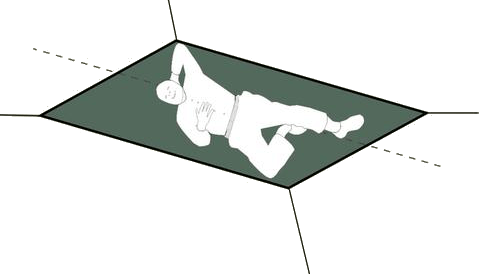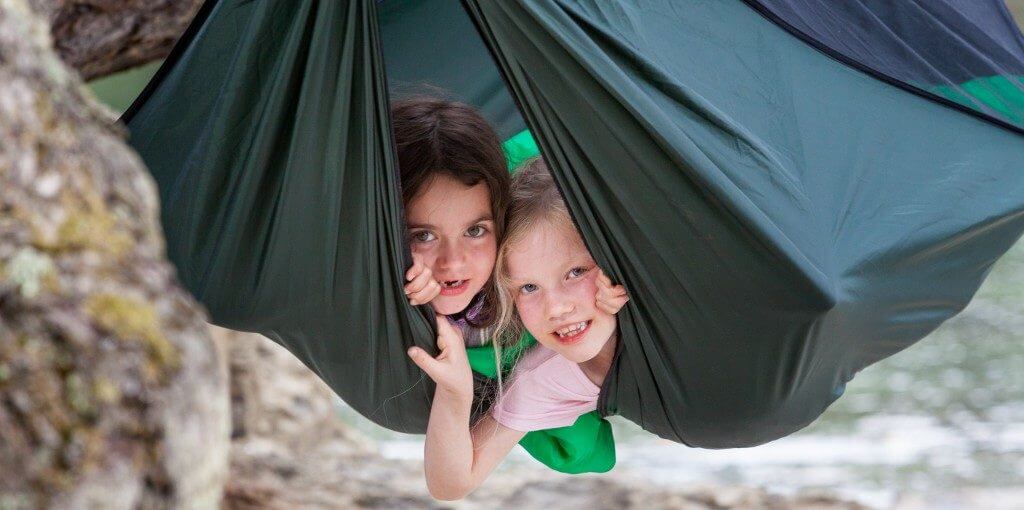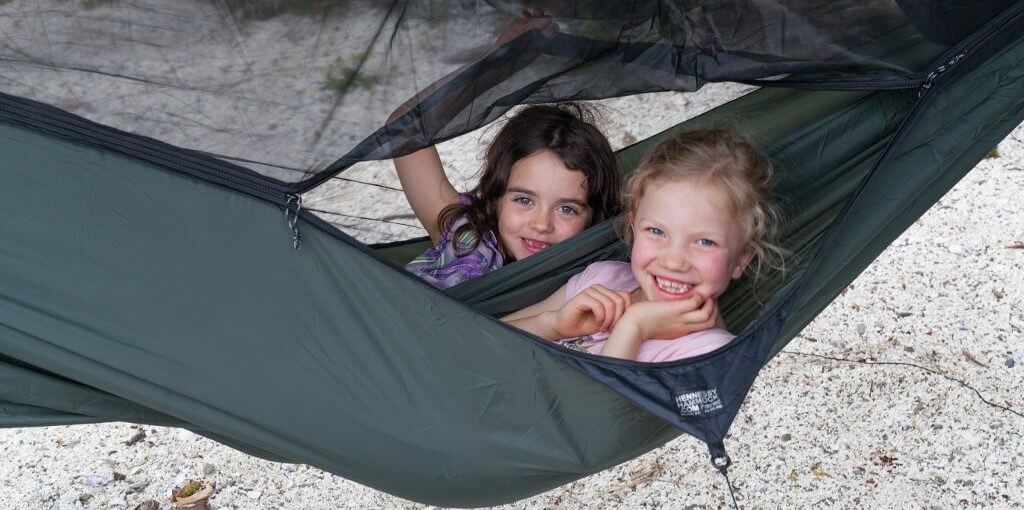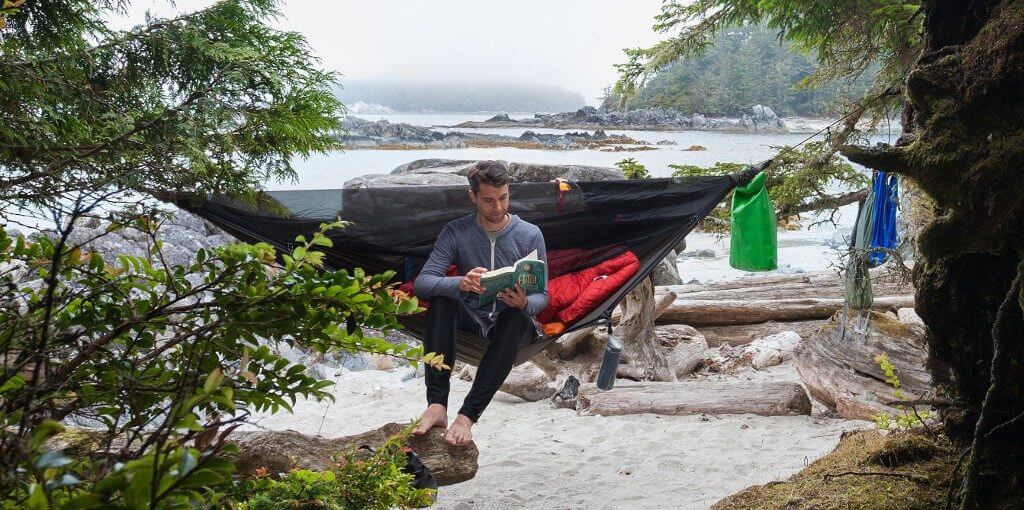Frequently Asked Questions
How long does it take to hang the hammock?
With a little practice, most people take around 3-10 minutes to hang the hammock, including attaching the cover, depending on the weather and terrain. The scout record is even 38 seconds.
How to hang the hammock correctly?
You can find detailed instructions on this topic on our website in the section“How to hang a hammock correctly“.
Where can I sleep in the hammock?
Even though it is not possible to forbid anyone to enter the forest for no reason, it is a bit more complicated. Czech law distinguishes between two concepts. One is camping and the other is bivouacking.
Camping can be interpreted as a multi-day stay in one place, where I pitch a tent and build a fireplace. This type of accommodation is only allowed in selected places or by prior arrangement with the landowner.
Bivouacking is understood as a one-off overnight stay that does not have a significant impact on nature. Generally, bivouacking is considered sleeping in the open air using a sleeping bag and a pad. Without starting a fire and without leaving any rubbish in the place of overnight stay. The important thing is that if bivouacking is not explicitly forbidden, it is allowed, unlike camping in forests and protected areas.
The line between the two concepts is quite narrow. In practice, it usually seems that if you pitch a tent somewhere, it is unfortunately seen as camping. With a hammock, the situation is a bit more cheerful, because provided you don’t build a fire and respect the rule “What you take to the countryside, you take with you”, sleeping in a hammock is considered bivouacking. Which makes it an ideal companion for the Czech nature.
Is there anything else I need to sleep in the hammock?
If you just want to rock comfortably in the hammock, the hammock alone is enough. If you are planning to go into the countryside and spend one or more nights in the hammock, be sure to take a sleeping bag, a sleeping bag and a mattress or underquilt. Don’t forget that sleeping in a hammock underneath you, unlike sleeping in a tent, lets air flow through and without underneath insulation you’ll be cold on your bum even on relatively warm nights.
What is a diagonal position?
The diagonal position is such a little secret of all hardened “hammockers”. Not everyone knows that the best way to sleep in a hammock is not in the classic “straight” position, when our body is in the same axis as the ropes and ridge line, but in the so-called diagonal position. This position is much more comfortable because you are not as bent over and the hammock does not press so much on your shoulders from the side.
To achieve the diagonal position, lie lengthways in the centre of the hammock (classic straight position). Then move your legs sideways by approximately 30°-45°, pressing them against the fabric of the hammock and moving the rest of your body. There we go! If everything has been successful, you can feel the hammock straightening up under you and, as well as suddenly having more space around you, you are also much more comfortable. This way of lying is especially comfortable for larger or asymmetrical nets.

In which positions can I lie/sleep in the hammock?
In a hammock, you sleep most naturally on your back. If you master sleeping in a diagonal position, you can also sleep comfortably on your side.
I can’t fall asleep in the hammock. What about it?
If, like me, you’re not one of those who had a great night’s sleep on your first night in the hammock, you might find some of these practical tips helpful. First, make sure your hammock is properly tied. If you do not have both ropes tied at approximately the same height, this can have a detrimental effect on your comfort. Another important thing is to lie down properly in the hammock. Lying in the net is most comfortable in a diagonal position. To further increase comfort when sleeping on your back, you can pad your knees with a pillow or piece of clothing. Some people find it comfortable to put a small pillow under their head. If you still don’t succeed, don’t despair. Sleeping in a hammock is different from sleeping in a tent or bed, where you have a solid ground under you. It may take some time to get used to this way of sleeping. Personally, it took me three nights to get used to sleeping in a hammock.
I normally sleep on my stomach. Sleep in a hammock?
I can’t promise you for sure, but it’s certainly possible. However, you will need to try sleeping on your back or side and it may take some time to get used to this position. I myself prefer to sleep on my stomach in bed, and I got used to sleeping on my back in a hammock after about three nights. The only advice I can give you is to try sleeping in a hammock for yourself.
Is it possible to sleep two in a hammock?
This is certainly possible in larger hammocks such as the Safari Deluxe Classic and Safari Deluxe Zip, provided you and your partner like to snuggle. Personally, I see hanging two hammocks side by side as a more comfortable solution.
What is a ridge line?
Ridge line is a weaker rope that is fixed between the suspension ropes above the hammock. Primarily it serves to keep the hammock ideally sagging at all times. It also supports a mosquito net and a waterproof tarpaulin, thus forming a small tent above you. As a bonus, you can hang a light or a smaller backpack on the ridge line. If not included in the hammock, the ridge line can be purchased separately.

What’s underquilt?
An underquilt, or also underblanket, is a system of insulation that is hung under the hammock. A traditional sleeping bag will compress underneath you in the hammock, providing poor thermal insulation. In contrast, a pocket of warm air is created between the underquilt and the hammock, which insulates perfectly so that you don’t get cold feet on cold nights. Just like sleeping bags, underquilts are divided according to the level of thermal insulation. In our shop you can find the three-season Underquilt OTUL and its lightweight variant Underquilt OTUL Lite, which is designed primarily for summer use.

Where should I put my shoes and backpack when I sleep in the hammock?
Depends on where you’re staying. If you are alone or with friends in a remote place, you can leave your backpack and shoes on a piece of plastic directly under the hammock. If you don’t want to leave your belongings on the ground, it is also possible to hang your backpack and shoes on the suspension ropes. Everything is hidden under a waterproof tarp so you don’t have to worry about things getting wet in the rain.
If you are staying in a place where there are a lot of strangers, it is better to take your backpack with you in the hammock. The most convenient solution seems to me to place the backpack next to my feet and attach it to the ridge line with a carabiner or string so that it doesn’t travel anywhere overnight. This solution may slightly reduce the comfort of sleep, but you don’t have to worry about something disappearing from your backpack overnight.
How should I store my hammock properly?
It is important to always make sure the hammock is dry before storing it! The ideal is to hang the hammock in a dry place when you get home from your trip and let it air out and dry before packing it up. This will prevent mould and colour degradation. The same applies to the waterproof cell. If the hammock or celta is dirty after being outdoors, wipe it with a damp cloth before drying.
Is a tent or a hammock better?
It cannot be said that a tent or hammock is clearly better. Both the tent and the hammock have their advantages and disadvantages and it depends on where and with whom you want to go.
A hammock is usually more compact than a tent and usually quicker to set up and take down. It is also more comfortable for many people. Another advantage of the hammock is that you can hang it even in uneven terrain and you don’t have to worry about finding a flat place where you won’t be pushed by a rock or a root and where the water stream won’t come through in case of rain. Personally, I also like more contact with nature. Watching the stars as you fall asleep, or being woken up by the sunrise, simply has something to it.
The tent is also a clear winner if we plan to go to places where there are no trees or other anchor points. The tent is also ideal if you’re travelling with more than one person and can spread the weight among your fellow travellers. A lot of people also appreciate the fact that a tent gives you more privacy.
What is the difference between a hammock with a bottom and side entry?
The Classic model, which has a Velcro bottom entry, allows you to get in and out of the hammock quickly and easily. This feature is appreciated not only by scouts and soldiers, but also by travelers who move in mosquito-infested environments.

The Zip model has a high quality YKK zipper along one full length of the hammock. This allows you to remove the mosquito net from one side of the net so you can easily put a car mattress and sleeping bag in the hammock. If you want, you can throw the mosquito net over the ridge line and relax in the open air.

Can the hammock come loose and fall off during rest?
If you tie the net properly to sufficiently strong trees and do not exceed the maximum load capacity of the hammock, you should not fall. However, I do not recommend hanging the hammock at dangerous heights or over dangerous ground. Remember also that the knots on the ropes will tighten overnight due to your weight and the hammock will drop slightly.
Can you sit in a hammock?
Definitely! For comfortable seating, it is best to hang the net between 40-50cm above the ground. With the Zip model, it is important to have the zipper fully unzipped before getting into the hammock. With the Classic model, you just need to fold the side of the net a little bit and then you can sit back and enjoy the nature.

I have a garden hammock at home. It’s great for summer relaxation, but I can’t imagine spending the night in it. Does it make sense to buy an outdoor hammock?
Before I decided to get my first “outdoor” hammock, I could not imagine that I could sleep comfortably in a hammock. My prejudices were mainly related to the fact that my only previous experience was resting in a classic garden hammock with spreader bars. After spending a few minutes in it, my eyes began to cut into my back. I solved this problem by placing a nice soft foam pad in the net and thought I had won. I realized my mistake after I woke up after a short nap and my whole body was aching, so to speak. Well, thanks to this experience I put the hammock in the category “Great for a momentary lazing around, but I wouldn’t want to sleep in it”.

The only thing our nets have in common with garden nets is their name and the fact that they are suspended in the air between two trees and can be swung around with ease. They are conceived in a completely different way and their main job is not only to serve for summer lounging, but mainly to be a reliable travel companion that allows you to sleep comfortably almost anywhere. Even though they are still called hammocks in Czech, they are not made of nets, but of highly resistant nylon. It comfortably supports your whole body and therefore nothing presses on you. Another practical “gadget”, which, unlike the built-in mosquito net, may not be obvious at first glance, is the asymmetrical shape of the hammock. Thanks to its diagonal position, it lies almost flat, so you’ll feel rested and ready for another day on the road after a night in it.
In short, I would summarize it like this: sleeping in a classic garden hammock and sleeping in an outdoor hammock are diametrically opposed. An outdoor hammock is primarily designed for sleeping and is therefore much more comfortable and stable. If you like to travel and try new things, don’t be afraid to give hammocks a chance.

